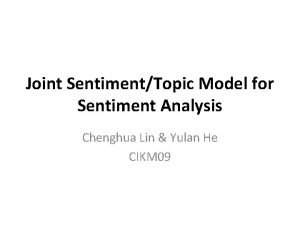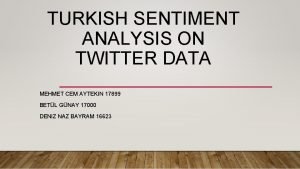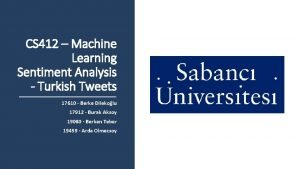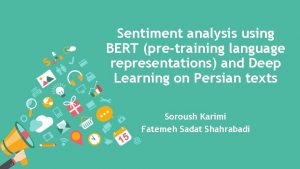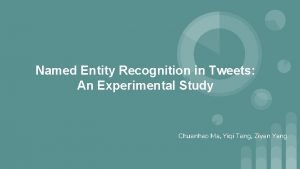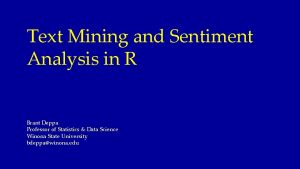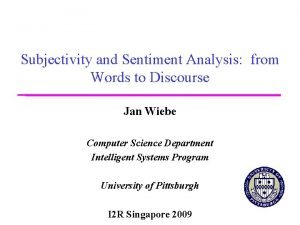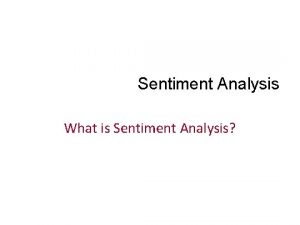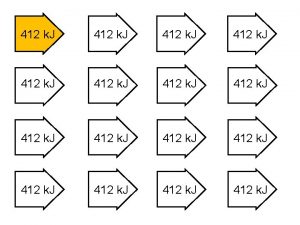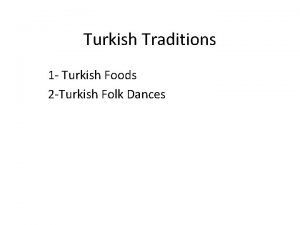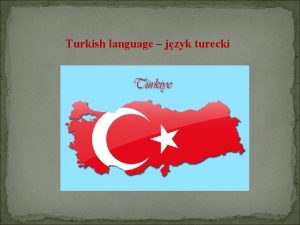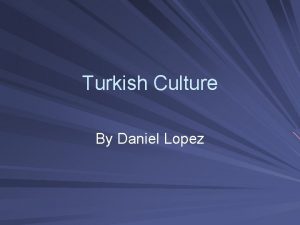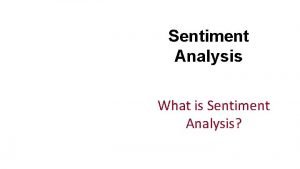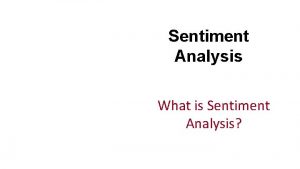CS 412 Machine Learning Sentiment Analysis Turkish Tweets








- Slides: 8

CS 412 – Machine Learning Sentiment Analysis - Turkish Tweets 17610 - Berke Dilekoğlu 17912 - Burak Aksoy 19080 - Berkan Teber 19459 - Arda Olmezsoy

I. Introduction to Problem Given: A number of tweets written about banks in Turkish Goal: Classify how bad or good a review is. • Features: Initially 21 Features are given. • Score Scale: Continuous, [-1(Very Bad), +1(Very Good)] • So: A REGRESSION problem.

II. Initial Data Analysis 01 02 03 Training Set: 757 tweets are given with their labels. Test Set: 200 tweets are going to be tested. Before starting our analysis we wanted to examine the 21 features given to us. We plotted how features are distributed over labels.

Example of a Good Feature Example of a Bad Feature We realized that Features 6, 8, 12, 15, 16, 17, 18 and 19 are similarly bad.

III. Additional Features • Since most of the features are not very informative, we decided to create our own features such as; Feature Name Explanation F 22 Whether tweet has : ) or not F 23 Whether tweet has : )) or not F 24 Whether tweet has : ))) or not F 25 Whether tweet has : D or not F 26 Whether tweet has : ( or not F 27 Whether tweet has : (( or not F 28 Whether tweet has : (((or not Feature Name Explanation F 29 Whether tweet has ! or not F 30 Whether tweet has ? or not F 31 Whether tweet has capital words or not F 32 Whether tweet has repeated letters/not F 33 Position of the @ in the tweet F 34 Common words score of the tweet

IV. Building Models • First we tried the training set without additional features on different Training Models such as Linear Regression, Decision Trees, Ensemble Methods, and SVMs. Model Name RMSE Ensemble – Boosted Trees 0. 39 Ensemble – Bagged Trees 0. 39 Tree – Simple Tree 0. 41 Tree – Medium Tree 0. 43 SVN – Median Gaussian SVM 0. 44 Trees performed better! -Why? Because…

Removed features numbered 6, 7, 8, 12, 15, 16, 17, 18 and 19 Model Name RMSE Ensemble – Boosted Trees 0. 39 Ensemble – Bagged Trees 0. 40 Tree – Simple Tree 0. 41 Tree – Medium Tree 0. 43 SVN – Medium Gaussian SVM 0. 43 With additional features 22 to 34 Model Name RMSE Ensemble – Boosted Trees 0. 37 Ensemble – Bagged Trees 0. 37 Tree – Simple Tree 0. 40 Tree – Medium Tree 0. 40 SVN – Medium Gaussian SVM 0. 41 • It seems like there is no significant improvement. However other models performed better. Because… • On High order models and Overfitting… • Finally, with meaningful additional features better results achieved!!

V. Conclusion • At the very end, we ended up with 5% better accuracy in our best model after removing some of the features and adding our own features. • Also, our correctly guessing rate has increased 81% to 85%.
